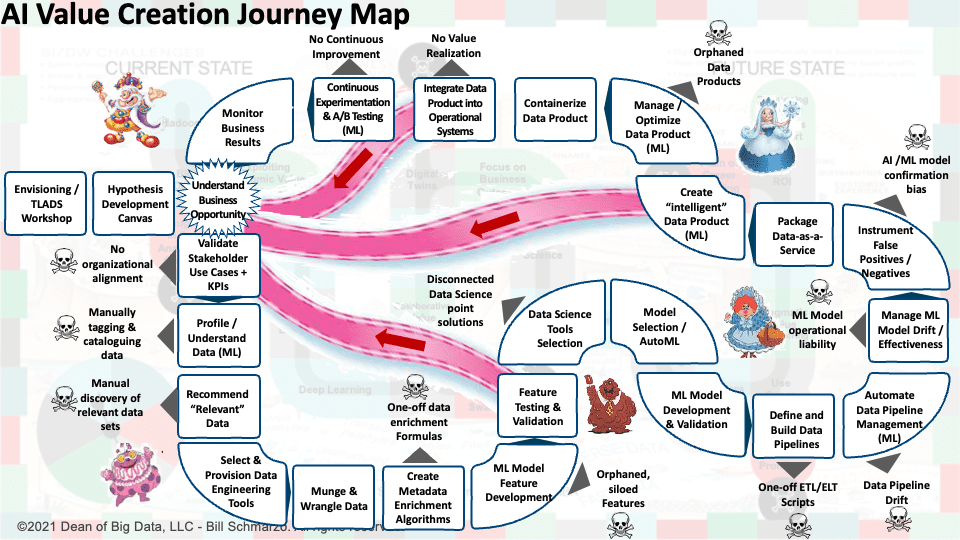Avoid falling for the seductive allure of artificial intelligence (AI) initiatives[1]. Resist the temptation to treat AI projects as conventional IT endeavors, assuming that methodologies employed in ERP / MRP / BFA / CRM implementations are universally applicable. Exercise caution when advised to “start small,” and instead, consider the following approach:
Initiate your AI journey with a small yet deliberate and strategic step, steering clear of haphazard beginnings.
Successful AI projects demand substantial investments in data, technology, human expertise, and organizational culture. This necessitates unwavering support from senior management to underpin these investments and sustain momentum as your organization harnesses AI to unlock novel customer, product, service, and operational value propositions.
However, securing senior management backing (along with the requisite financial resources) is not achievable through a scattershot selection of use cases. Senior executives prioritize investments in initiatives that yield tangible, measurable business and operational benefits. They seek to concentrate on endeavors that align with strategic business imperatives. Senior leadership is inclined towards focusing on pivotal business initiatives (refer to Figure 1).
 Figure 1 : Strategic Business Initiatives
Figure 1 : Strategic Business Initiatives
Deciphering Your AI Investment Imperatives
While the prospects for AI are promising (don’t forget your shades!), organizations must be ready to invest in enhancing their data, technology, human capital, and cultural competencies to craft an AI strategy that drives business and operational triumph.
1) Data. The cornerstone of organizational success lies in data investments. This encompasses the meticulous management, governance, and enhancement of data quality, granularity, latency, and enrichment. The efficacy and reliability of your AI models hinge entirely on the precision, dependability, and timeliness of your data. However, it is imperative to discern and prioritize relevant and valuable data sets that align with your organizational objectives. Focus your data management and governance efforts on datasets that bolster the realization of strategic business goals.
2) Technology. Organizations must brace themselves for investments in cutting-edge data management, data engineering, and analytics processing technologies. For detailed insights into the technological prerequisites for your AI expedition, explore the AI design guide by Dell Technologies.
Although technology isn’t my forte, I comprehend analytics and its application in cultivating fresh streams of business and operational value. The advent of autonomous analytics, capable of learning and adapting with minimal human intervention, is poised to revolutionize various facets of society. This transformation will elevate healthcare standards, combat environmental challenges, address transportation safety concerns, expedite manufacturing excellence, promote social and economic parity, and much more.
Autonomous Analytics often relies on reinforcement learning (RL) to assimilate knowledge from experiences and feedback. For instance, Reinforcement Learning (RLHF – Reinforcement Learning with Human Feedback) empowers Generative AI products like ChatGPT, Bing AI, and Google Bard to evolve through human interactions.
3) People Skills. Data science thrives on collaborative efforts involving Data Engineers, Data Scientists, and Business Stakeholders. Evaluating and enhancing people’s skills necessitates adopting a standardized framework such as the “Thinking Like a Data Scientist” model, which facilitates skill assessment and development (refer to Figure 2).
 Figure 2 : The Art of Thinking Like a Data Scientist Methodology
Figure 2 : The Art of Thinking Like a Data Scientist Methodology
Another vital aspect of honing people’s skills involves clearly delineating the roles, responsibilities, and expectations of Data Engineers, Data Scientists, and Business Stakeholders. This clarity fosters the delivery of pertinent, meaningful, ethical, and responsible business and operational outcomes.
4) Cultural Transformation. Even with a robust data management strategy, advanced technology infrastructure, skilled workforce, cultural empowerment is indispensable.
Cultural empowerment entails embracing ambiguity, diversity, collaboration, experimentation, and learning from setbacks.
The linchpin for AI triumph is cultural empowerment, characterized by:
- Personalizing the Organizational Mission to ensure everyone is aligned with the mission and comprehends how their contributions drive its success.
- Adopting Customer-Centric Communication by articulating aspirations, needs, and challenges in a language that resonates with customers.
- Nurturing Organizational Agility by fostering a culture of experimentation and adaptability, where employees are encouraged to innovate, learn from failures, and swiftly adjust to changing scenarios.
- Embracing Diverse Perspectives to view differing viewpoints as complementary rather than conflicting, fueling innovation.
- Encouraging Inclusive Dialogue by amplifying unheard voices, nurturing open discussions, and embracing dissent.
- Fostering Curiosity, Creativity, and Innovation to instill a culture of exploration, learning, and invention, enabling breakthrough advancements.
Embarking on a successful AI odyssey mandates investments in four pivotal realms: data, technology, human expertise, and cultural metamorphosis. These domains are interconnected and mutually reinforcing, requiring alignment with your strategic vision and objectives. Data serves as the lifeblood, technology as the driving force, human skills as the navigators, and cultural transformation as the guiding principle. By investing judiciously in these areas, you can unleash AI’s potential to innovate, create value, and metamorphose your organization (refer to Figure 3). 🚀
 Figure 3 : Why Data Management is Today’s Most Important Business Discipline
Figure 3 : Why Data Management is Today’s Most Important Business Discipline
Commence with Precision and Purpose – Part 1: Synopsis
The domains of data, technology, human expertise, and culture demand substantial investments in time, resources, and perseverance to nurture and amplify AI’s transformative prowess. Such investments, laden with potential, should be directed towards initiatives of strategic significance to your organization – a strategic business initiative. In Part 2, we will delve deeper into strategic business initiatives and their associated use cases.
[1] The term “siren song” symbolizes something enticing and captivating but ultimately perilous, deceptive, or ruinous.










